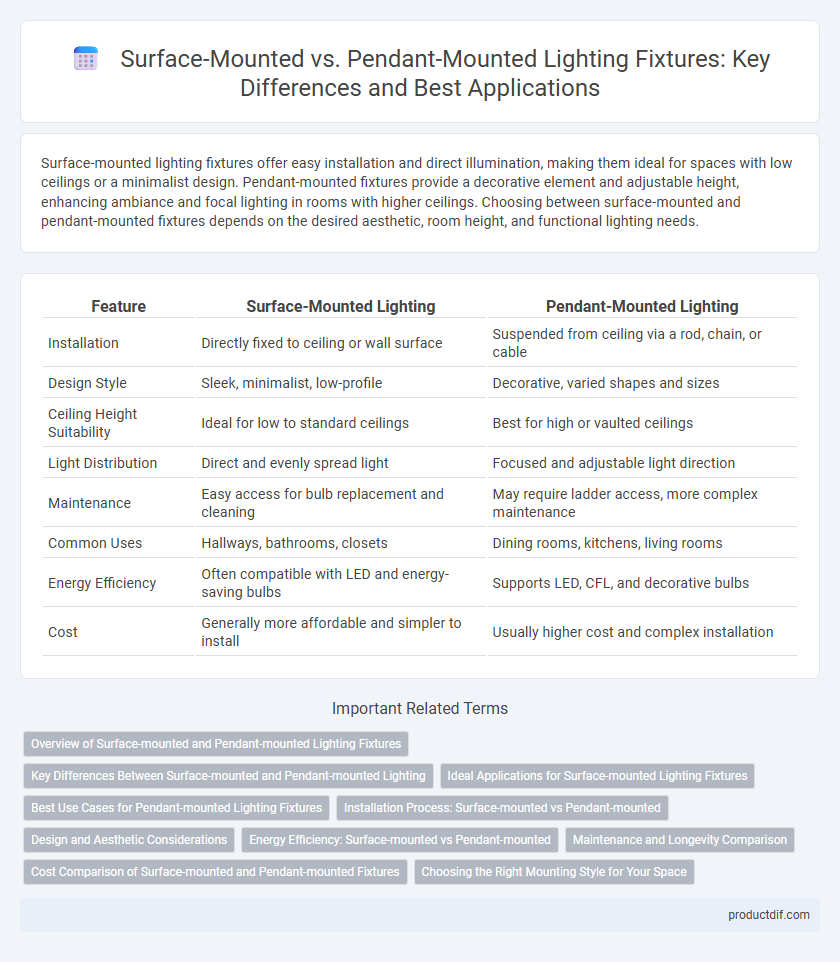Surface-mounted lighting fixtures offer easy installation and direct illumination, making them ideal for spaces with low ceilings or a minimalist design. Pendant-mounted fixtures provide a decorative element and adjustable height, enhancing ambiance and focal lighting in rooms with higher ceilings. Choosing between surface-mounted and pendant-mounted fixtures depends on the desired aesthetic, room height, and functional lighting needs.
Table of Comparison
| Feature | Surface-Mounted Lighting | Pendant-Mounted Lighting |
|---|---|---|
| Installation | Directly fixed to ceiling or wall surface | Suspended from ceiling via a rod, chain, or cable |
| Design Style | Sleek, minimalist, low-profile | Decorative, varied shapes and sizes |
| Ceiling Height Suitability | Ideal for low to standard ceilings | Best for high or vaulted ceilings |
| Light Distribution | Direct and evenly spread light | Focused and adjustable light direction |
| Maintenance | Easy access for bulb replacement and cleaning | May require ladder access, more complex maintenance |
| Common Uses | Hallways, bathrooms, closets | Dining rooms, kitchens, living rooms |
| Energy Efficiency | Often compatible with LED and energy-saving bulbs | Supports LED, CFL, and decorative bulbs |
| Cost | Generally more affordable and simpler to install | Usually higher cost and complex installation |
Overview of Surface-mounted and Pendant-mounted Lighting Fixtures
Surface-mounted lighting fixtures are installed directly onto a ceiling or wall, providing a sleek and low-profile illumination solution ideal for rooms with standard or low ceilings. Pendant-mounted fixtures hang from the ceiling by a rod, chain, or cord, allowing adjustable height and creating focal points in spaces such as dining areas or entryways. Both types offer versatility in design and functionality, tailored to accommodate different ceiling heights and lighting needs.
Key Differences Between Surface-mounted and Pendant-mounted Lighting
Surface-mounted lighting fixtures are installed directly onto the ceiling, offering a sleek and space-saving design ideal for low ceilings or minimalist interiors. Pendant-mounted lighting hangs from the ceiling by a rod or chain, providing adjustable height and a decorative element suitable for dining areas or high-ceiling spaces. Key differences include installation complexity, light distribution, and aesthetic impact, with surface-mounted fixtures delivering more uniform light and pendant lights focusing illumination downward for task or accent lighting.
Ideal Applications for Surface-mounted Lighting Fixtures
Surface-mounted lighting fixtures are ideal for spaces with low ceilings, such as corridors, closets, and small rooms, where ceiling height is limited. They provide uniform illumination and are easy to install on flat surfaces without requiring extensive wiring or ceiling modifications. These fixtures are commonly used in offices, residential areas, and commercial spaces where functional, unobtrusive lighting is essential.
Best Use Cases for Pendant-mounted Lighting Fixtures
Pendant-mounted lighting fixtures are ideal for creating focused illumination over dining tables, kitchen islands, or workspaces, enhancing task visibility and adding aesthetic appeal. Their adjustable height and design versatility make them perfect for layering light in living rooms or entryways, offering both functional and decorative benefits. Pendant lights excel in open-concept spaces where ceiling height allows for dramatic and visually impactful lighting arrangements.
Installation Process: Surface-mounted vs Pendant-mounted
Surface-mounted lighting fixtures install directly onto the ceiling, requiring minimal wiring and straightforward mounting, making the process faster and ideal for low ceilings. Pendant-mounted fixtures need secure ceiling hooks or brackets and careful wiring for suspension, demanding more time and precision, especially with adjustable cords or rods. Both methods require ensuring electrical connections comply with safety standards, but surface mounting typically offers easier access for routine maintenance.
Design and Aesthetic Considerations
Surface-mounted lighting fixtures offer a sleek, minimalist design that seamlessly integrates with ceilings, ideal for modern, low-profile aesthetics and maximizing room height. Pendant-mounted fixtures serve as focal points, providing customizable styles and varying drop lengths to enhance visual interest and complement diverse interior themes. Choosing between these options depends on desired ambiance, spatial dynamics, and the balance between practicality and decorative impact.
Energy Efficiency: Surface-mounted vs Pendant-mounted
Surface-mounted lighting fixtures typically offer higher energy efficiency by minimizing light loss due to shorter distances between the fixture and the illuminated surface, resulting in reduced wattage requirements. Pendant-mounted fixtures can be less energy-efficient because they often require higher wattage or more powerful bulbs to achieve adequate illumination over greater distances. Choosing surface-mounted lighting in commercial or residential spaces can lead to lower electricity consumption and reduced energy costs while maximizing luminous efficacy.
Maintenance and Longevity Comparison
Surface-mounted lighting fixtures offer easier maintenance due to their accessible installation on ceilings or walls, allowing for quick bulb replacements and cleaning without specialized equipment. Pendant-mounted fixtures, while aesthetically appealing, often require more time and tools for upkeep, as they hang lower and may need ladder access for maintenance tasks. In terms of longevity, surface-mounted designs typically experience less wear from environmental exposure, enhancing their durability compared to pendant fixtures, which can be more susceptible to dust and damage due to their suspended position.
Cost Comparison of Surface-mounted and Pendant-mounted Fixtures
Surface-mounted lighting fixtures generally offer a lower installation cost compared to pendant-mounted fixtures due to simpler mounting hardware and minimal ceiling modifications. Pendant-mounted fixtures often require additional structural support and longer wiring runs, increasing labor and material expenses. Budget considerations favor surface-mounted options for cost efficiency without sacrificing functional lighting quality.
Choosing the Right Mounting Style for Your Space
Surface-mounted lighting fixtures offer a sleek, space-saving solution ideal for rooms with low ceilings or where minimal disruption to the ceiling structure is desired. Pendant-mounted fixtures provide a versatile design element, perfect for adding visual interest and directing light in areas like dining rooms or kitchens with higher ceilings. Selecting the right mounting style depends on ceiling height, room function, and the desired ambiance to optimize both lighting effectiveness and aesthetic appeal.
Surface-mounted vs Pendant-mounted Infographic

 productdif.com
productdif.com